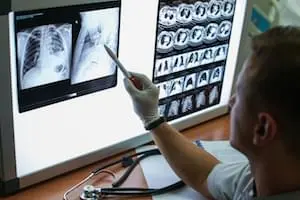Keeping Care Close

New Adena thoracic surgeon saves patients a long trip away from home
The diagnosis was not what worried Karen Grow, 67. It was the treatment that was the cause of her concern.
Grow, who lived in Chillicothe for 40 years before moving to Waverly, had been diagnosed at Adena Cancer Center with thymoma, a type of cancer that grows in the chest. Her tumor was small but located under the chest bone. To remove it, her physician told her a surgery would be required. That is crack open the chest, followed by three months of recovery.
Thankfully, Grow had a local option that was minimally invasive and would significantly reduce her recovery time. Kevin Radecki, MD,a thoracic surgeon who specializes in cancers of the lung and chest, had just joined Adena medical staff. Using the da Vinci XI robot, Radecki could perform the surgery through three small incisions next to Grow’s pectoral muscle. The procedure could be performed in less than an hour, and would require only 10 days of recovery.
“The very next morning after coming home, I swept, did laundry, and made my bed,” says Grow, who just a week after surgery was busy crocheting scarves for local cancer patients and nursing home residents.
Robotic Precision
Radecki joined Adena’s team in December 2018. It’s addition has made a huge difference for patients. No longer do they need to travel to Columbus for state-of-the-art cancer surgery. Specializing in surgeries using the da Vinci robotic system, Dr. Radecki performs most procedures through just a few small incisions. This type of surgery, known as minimally invasive, has huge advantages to patients. Typically, patients lose less blood, have shorter hospital stays, and recover faster, Radecki says.
“It’s still an operation, but a lot less invasive,” he adds. “The pain is less, mobility comes back quicker, recovery is a lot faster for even a lung cancer resection. Basically, getting back to your baseline is quicker.”
Adena now has five robotic surgical systems, including the most sophisticated model of the da Vinci—the da Vinci XI. This surgical system not only benefits the patient, it allows the surgeon to be much more precise.
Sitting at a console beside the patient, the surgeon can view the surgical site in three-dimensions with magnification 10 times greater than the human eye. The surgical robot is also more flexible. Unlike the human wrist, the da Vinci surgical arms can rotate 360 degrees, giving the surgeon access to parts of the body unreachable with traditional surgery. The da Vinci also has built-in tremor control to neutralize any extraneous movements that might be made by the surgeon. Combined, these features mean surgeons can perform procedures within 1 millimeter of accuracy; standard surgery has an acceptable margin of error of 3-5 mm.
Big-City Care
Prior to joining Adena, Radecki was treating patients in Columbus. He hadn’t thought a rural area could provide the level of services available in a larger city. But when colleagues recommended he look south, he was pleasantly surprised.
“I was impressed with the resources Adena provides for the nine counties surrounding it,” Radecki says. “Adena has its own cancer center, and is part of huge network of clinical trials that occur anywhere in the world, so patients can stay here to receive the most advanced treatments. It surprised me, and has been very rewarding to be able to help patients stay close to home for treatment."